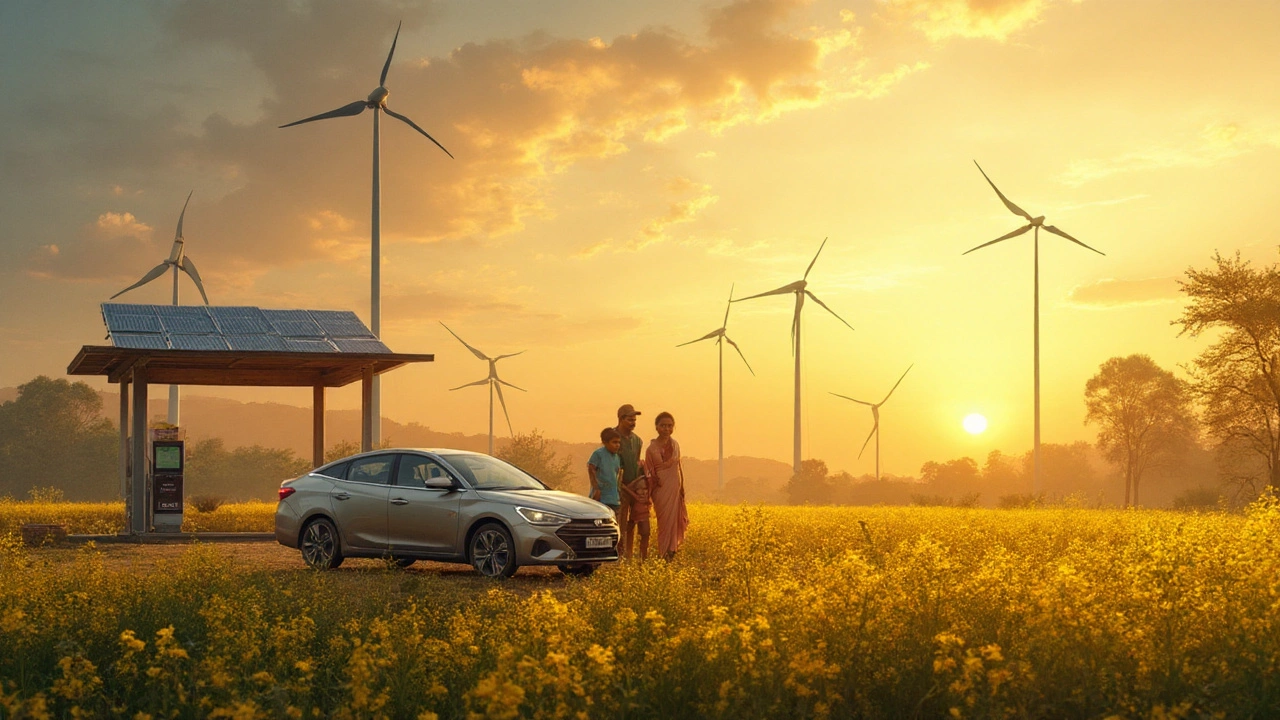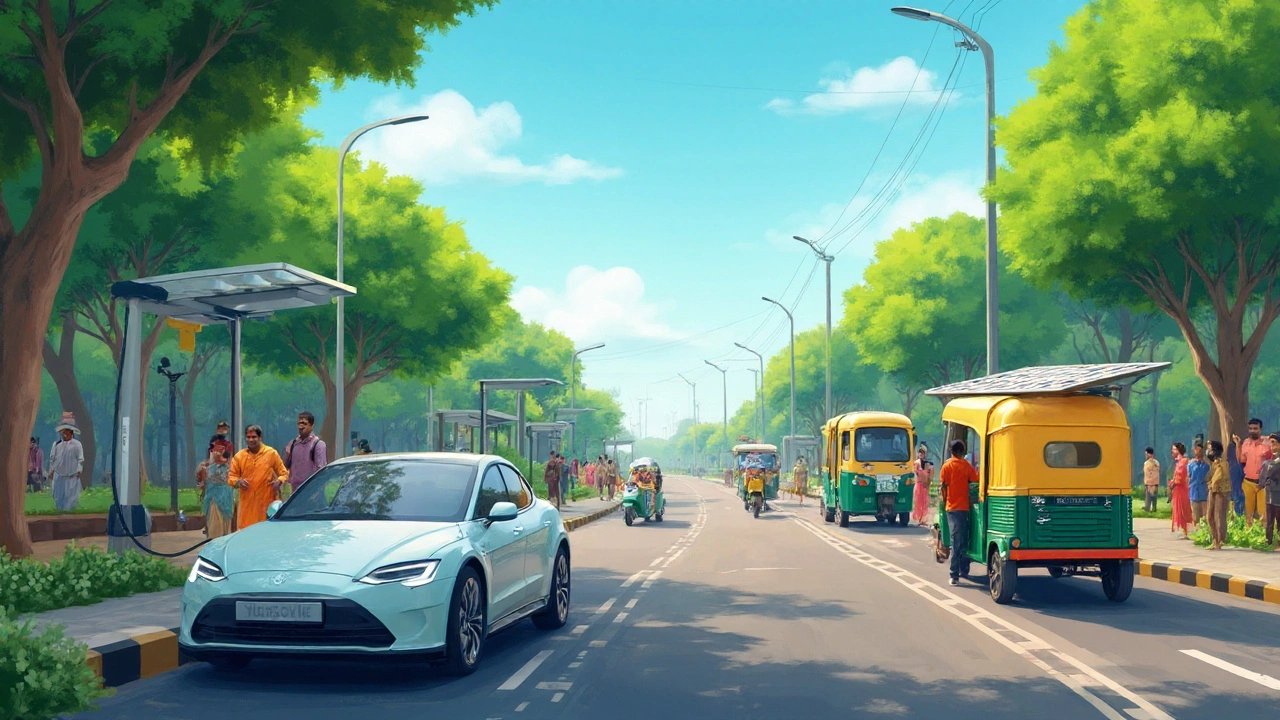It’s wild to think how we’re still stuck pumping fossil-based gasoline into our cars, despite all the breakthroughs happening around us. The world’s running headlong into a climate crisis, gas prices in Bangalore shoot up every few months, and I see my kids, Ishan and Kavya, already asking why there are so many cars belching smoke on their way to school. The truth? People everywhere are done with dirty fuels. But with such noisy talk about going green, what could actually replace gasoline under the hood of your next car? No, it’s not science fiction anymore—renewables have quietly been fighting for that spot. Forget smoky trips to the petrol bunk; the race is on for a new way of driving.
How Cars Can Run on Renewable Energy
The biggest thing blocking change isn’t the lack of new tech—it’s us. We love convenience, and let’s be honest, swapping decades of gas stations for something new makes most drivers nervous. But take one look at the options, and you’ll see that the shift is already rolling faster than many realize. The clear leader by miles is electric vehicles (EVs). These cars skip liquid fuel altogether. Pop open the hood of a new Tata Nexon EV or Tesla Model Y, and you’ll see massive battery packs. They’re filled with stored electricity, which can be made from renewable sources like solar or wind. The real-world proof? In 2024, more than 10 million EVs were sold globally, and here in India, the EV market grew 74% in just a year. In certain cities, public buses, delivery fleets, and sometimes even rickshaws have already switched.
Charging EVs is pretty straightforward. Plug your car into a charger—at home, the mall, even tech parks now—and let the lithium-ion battery top up. But where’s that electricity coming from? If your neighborhood gets power from hydro, wind, or solar, then your commute is basically guilt-free. Yet, there’s a catch. Charging takes longer than a gas station visit—it can be 30 minutes with a fast charger, or hours at home—and range anxiety is still real for people in rural India or those planning long road trips.
But electricity isn’t the only path. Hydrogen fuel cells are another talked-about contender. Instead of a battery, hydrogen cars use a fuel cell that combines hydrogen gas and oxygen from the air to make electricity, with the only tailpipe output being pure water vapor. The Toyota Mirai and Hyundai NEXO are real world models already hitting the streets—not theory. The upside? Refueling a hydrogen car takes about the same time as filling up with petrol, and these cars can go even longer distances between fill-ups. Here comes the letdown—the lack of fueling stations. Even in the US and Japan, which are pushing hydrogen tech, stations are rare. In India, the first pilots are only starting now. Producing hydrogen is another challenge, especially if you want it green. Doing it via electrolysis with solar or wind power is expensive, and the infrastructure for distribution is nearly nonexistent at scale.
You’ll hear some bold talk about biofuels, like ethanol and biodiesel, which are made from plants or waste instead of crude oil. They can slot into existing engines with some modifications, and Brazil actually runs millions of cars on sugarcane ethanol today. But growing crops for fuel can end up fighting for land, water, and food resources. India dabbled with E20 fuel—20% blended ethanol—and it’s rolling out more pumps, but biofuels can’t solve emissions and land use in the long run. Algae-based and advanced cellulosic biofuels might tip the scales, but they’re still mostly at the pilot stage, with costs not competitive yet.
Let’s not forget solar cars—sounds dreamy on paper, but the reality is limited by rooftop space and how much sunlight you get. Scientists are still pushing, but unless we get radical advances in panel efficiency, you probably won’t be cruising Bengaluru’s Outer Ring Road running directly on sunbeams soon.
What about real-life comparisons? Here’s a quick view of how the main contenders stack up.
| Energy Source | Commercial Availability (2025) | Refueling Time | Range per Fill | Emissions | Key Barriers |
|---|---|---|---|---|---|
| Electric (Battery) | Common (India, Global) | 30 mins to 12 hours | 220-600 km | Zero (if green energy used) | Charging time, battery disposal, grid source |
| Hydrogen Fuel Cell | Limited (Pilot/Asia/US) | 3-5 mins | 500-700 km | Water vapor only | Few stations, costly production |
| Biofuel (Ethanol/Biodiesel) | Moderate (Brazil, US, India) | 2-5 mins | 400-600 km | Reduced, not zero | Food vs. fuel, land use |
| Solar (Direct) | Experimental | NA | 50-100 km (theoretical) | Zero | Panel efficiency, weather |
This table shows why electric cars—especially those running on a renewable-powered grid—are winning the race right now. They’re practical, you can already buy and use them, and governments (including India’s FAME program) keep tossing out incentives. Hydrogen will probably move behind the scenes for buses, trucks, and maybe trains, but unless you like spending crores on custom cars, you won’t see hydrogen pumps at every corner soon.

Can Renewable Energy Power a Car Like Gasoline?
When someone says they can’t give up gasoline because nothing else “feels right,” I get it. Stepping away from the roar of a petrol engine and into the near-silent whirr of an EV is a big leap. The good news? Renewable energy is closer to matching the punch of petrol than you might think. Electric motors deliver instant torque, so even practical family cars feel zippy. The new MG ZS EV, for example, goes from 0 to 100 kmph in under 8.5 seconds—faster than some classic hatchbacks. Even heavy SUVs and luxury sedans are switching to battery power without losing their muscle. Tesla’s Plaid Model S? It’s record-breaking, doing 0-100 in 2.1 seconds. Now, that’s not something your local Maruti can do on petrol!
The catch with renewables isn’t power, but range and refueling speed. Gasoline made car travel possible because you could pull up at any station and fill up in minutes, then drive 500-800 km before thinking about the next stop. Today’s best EVs deliver 400-600 km on a full charge. For most daily users, that’s plenty, but if you’re heading on a family road trip to Coorg or Goa, charging breaks will be part of your plan. Some new fast chargers put out 350 kW—like those at select Indian expressways—can juice up a compatible EV for another 200 km in under ten minutes. That’s still slower than a gas pump, but way better than sitting for hours. The real trick is planning ahead and using charging station apps before you set off.
No one wants to be stranded. Battery tech is where scientists are hustling. New sodium-ion and solid-state batteries might double storage, cut charging times, and slash fire risk. Manufacturers like CATL, Toyota, and Ola have already revealed prototypes with real-world testing happening in 2025. A solid-state battery-powered EV could go from 10% to 80% in just twelve minutes—or even less—turning the old “range anxiety” into a thing of the past.
Hydrogen? It’s got the speed, but with only a handful of working pumps, it can’t match gasoline for convenience. But keep an eye on heavy truck logistics; companies like Reliance and Indian Railways are exploring hydrogen for long-distance transport, since big loads and refueling speed matter more there than in daily passenger cars. Hydrogen cars also hold more energy per kilo than batteries do, so they could eventually close the performance gap entirely.
Looking at biofuels, the pros are strong: you don’t need to rebuild the car industry from scratch. Swapping regular petrol for, say, E20 ethanol in an existing Maruti or Honda is simple and cheap, especially if the car is designed for flex fuel. Emissions drop, but not to zero—growing, harvesting, transporting, and refining biofuels still burns energy and creates pollution. Still, if India swapped to higher ethanol blends for all cars, we’d cut oil import costs and reduce our carbon footprint a fair bit. But if farmers switch fields from food crops to fuel crops, the price of basic foods could go up—something no parent wants to see.
Solar cars sound like magic, but the physics is stubborn. A midsize family car needs about 20-25 kWh to run 100 km. Even with the best panels out there, the roof and hood together might harvest 4-6 kWh on a bright day—not enough for full-time cruising, unless you’re in the Sahara. So, solar’s best used as a battery charger, not a direct drive system. That said, adding rooftop solar panels to homes and charging your car from home-grown electrons is a sweet deal in sunny places like Bangalore.
The main reason to switch, though? Clean air for our kids. Vehicles are the single biggest source of PM2.5 particles in Indian cities. That haze on the morning school run? Mostly from petrol and diesel tailpipes. Each EV or hydrogen vehicle we swap in means a drop in local pollution—and that’s something everyone feels, even before the planet-saving bonus. Several studies show that if 30% of India’s cars become electric by 2030, tailpipe emissions could fall by over 16%, a lifesaver in crowded cities.

Tips for Choosing the Right Renewable Energy Car
Thinking of ditching your petrol car for something greener? Here are some practical steps and insider tips to get it right, plus a peek into daily life with renewables.
- Plan your budget: EVs can cost more upfront, but with fewer moving parts and less maintenance (no oil changes!), you’ll spend less year after year. Government rebates like the FAME II scheme make new EVs more accessible. Don’t forget to factor in used EV prices—they’re falling fast as more people upgrade.
- Charging at home beats waiting in queues: If you can install a home charger (even a regular three-pin socket works in a pinch), you wake up to a full “tank” every day. Apartment dwellers? Several new societies in Bangalore now have shared EV charging stations. Ask your builder or resident’s association about this before you buy.
- Scope out public infrastructure: Use apps like Statiq or Tata Power EZ Charge to map out charging spots before heading out. Fast charging stations are popping up on highways between big cities—perfect for family outings. Just remember, fast charging too often can wear batteries down a bit faster, so use it when needed.
- Think about daily driving needs: Be honest here—most people drive less than 50 km per day. Even a basic EV covers twice that range. If your kid’s school and your office are within city limits, an EV’s range will rarely leave you stranded.
- Follow the maintenance rhythm: No complex engines or exhausts to fix! EVs have fewer fluids to check and brake systems last longer (thank regen braking for that). Just rotate tires, replace batteries every 8-10 years, and you’re set. Hydrogen cars and hybrids are getting simpler too, but check for servicing options in your city.
- Check resale and after-sales support: Brand new EVs and hybrids from Tata, Hyundai, and MG now hold value better as people get over the old battery anxiety. Find dealers with good warranties and responsive customer support—spare parts are still a growing business, especially for newer technologies.
- For the adventurous: join a carpool or shared mobility program: Ride an EV without owning it. Tons of cities, including Bangalore, have services like BluSmart or Yulu offering green rides for city commutes.
If you live in a place with unstable grid power, consider solar panels for your house. Combine enough rooftop solar with battery storage, and you could run your car almost entirely off sunshine—a dream that used to sound ridiculous but is now becoming practical for those who invest in the setup.
The shift away from gasoline isn’t just about saving the planet, even though that’s a huge part. It’s about cleaner air for our families, less noise, and less hassle. Electric cars are already here and ready for most drivers. Hydrogen, biofuels, and solar all have a role to play, but if you want the simplest switch? Plug in, charge up, and roll out—no petrol needed. The only real question left is: are you ready for the change, or will your next car just add to the smog Kavya and Ishan breathe every morning?





